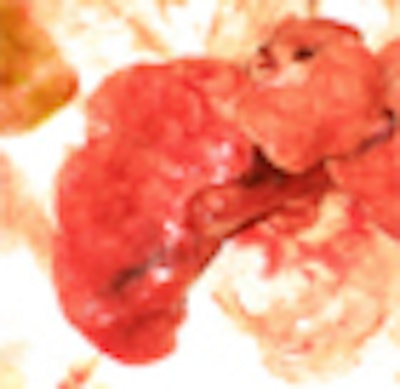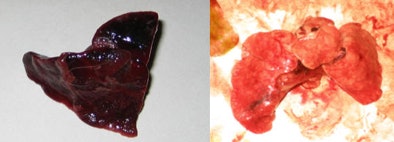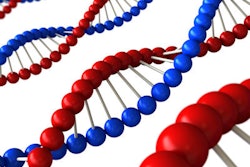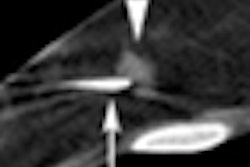
Can swallowing a pill before your next CT scan prevent oxidative tissue damage from radiation? Developers promoting a new line of nutritional supplements called BioShield say it can, and they're gearing up to sell the product as a patient protection tool for hospitals and other entities that use ionizing radiation.
With CT scan utilization continuing to rise for a growing list of clinical indications, recent years have witnessed a concerted effort on the part of governments, scanner manufacturers, and physicians to trim the radiation burden for patients to levels that are as low as reasonably achievable (ALARA), thereby reducing the theoretical risk of cancer that can occur years after a patient is exposed.
Taking another angle on the dose dilemma is Premier Micronutrient, a Nashville, TN, company that has developed a line of antioxidant formulas called BioShield. Premier believes that BioShield can reduce the harm of medical imaging exposure to radiation by preventing a proven mutagenic -- oxidative free radicals -- from harming human tissues exposed to the CT scanner's x-ray beam.
Risk reduction
If antioxidant protection were proved to be effective, risk reduction would no longer be limited to getting dose as low as possible, but would also include shielding patients before they're exposed.
Working to get BioShield into imaging centers is Dr. James Ehrlich, atherosclerosis imaging expert and founder of Colorado Heart and Body Imaging, a Denver-based chain of imaging centers. Ehrlich serves as a clinical collaborator and advisory board member for Premier Micronutrient.
 |
| BioShield boxes. Image courtesy of Dr. James Ehrlich and Premier Micronutrient. |
Free radicals can attach themselves to DNA and, in the absence of adequate repair mechanisms, damage it, Ehrlich said. To the extent that mutagenesis and carcinogenesis are considered related phenomena, radiation-induced DNA damage can help explain the observed link between radiation exposure and cancer, he added.
The more controversial aspects of radiation's effects, for example, the hormesis theorem, which holds that low-level radiation can have a protective effect, "have pretty much been discarded," Ehrlich said, adding that ionizing radiation was added to the U.S. Department of Health and Human Services' (HHS) list of carcinogens in 2005.
The antioxidant cocktail
For a little more than a decade, Premier has been developing and selling customized combinations of micronutrients for a variety of applications, Ehrlich said. No claims are made that the patented formulas prevent cancer; rather, the products are claimed to offer a measure of protection against the effects of ionizing radiation. Under U.S. Food and Drug Administration (FDA) rules regulating U.S. nutritional supplements, component ingredients only need to be generally recognized as safe to be sold without a prescription.
In the case of BioShield, the product's developers "wanted to develop a cocktail of antioxidants, each of which has been shown to effectively decrease the biomarkers of oxidative stress, and which would reach high blood levels shortly before the imaging procedure, or, for example, an airline flight," Ehrlich said. It's analogous to wearing a hat or applying sunscreen before going out in the sun, he said.
"I applied the concept of PAMARA, or 'protect as much as reasonably achievable,' " to the well-known concept of ALARA, he said. "The idea is that of a safe, efficient, free-radical scavenger that could be given to a patient 30 minutes before a procedure."
Early research
It's been known for decades that nontoxic antioxidants exhibit radiation protection, because radiation damage is caused primarily by free radicals generated during irradiation, according to Kedar Prasad, Ph.D., Premier's chief scientific officer, in an interview.
There are multiple studies (12 in vitro studies, 15 animal studies, and four human studies) showing that antioxidants neutralize these free radicals, said Prasad, a radiation biologist.
Key antioxidants in the formula include beta-carotene, vitamin C, vitamin E (alpha-tocopherol and alpha-tocopheryl succinate), selenium, alpha-lipoic acid, and N-acetylcysteine. Alpha-tocopheryl succinate has been found to be the most effective form of vitamin E in reducing radiation damage, Prasad told AuntMinnie.com.
But they don't all work the same way. Antioxidants have complex mechanisms of action in addition to neutralizing free radicals, Prasad said. They are distributed in the body in different ways, their affinity for free radicals differs, and even some of their mechanisms of action in cells differ.
"They all destroy free radicals, but they have markedly different effects on genetic activity," Prasad said. "So to take maximum advantage of that, you combine it all in a mixture, and that's what we have done in BioShield."
In cooperation with NASA and the Russian Academy of Sciences, Prasad said that he and his colleagues recently tested the efficacy of an antioxidant mixture on animals receiving high doses of whole-body gamma radiation.
One experiment tested BioShield in two groups of 10 mice, each of which received 8.5 Gy (8,500 mSv) of radiation, with one group receiving oral antioxidant treatment before irradiation while the other did not. The group that wasn't treated experienced 100% mortality within 30 days, whereas the group that received therapy had a 40% survival rate, Prasad said.
A similar experiment tried oral antioxidant treatment in two pairs of sheep, both of which received whole-body gamma radiation of 4.41 Gy (4,410 mSv). The group that did not receive therapy experienced 100% mortality in seven days from gastrointestinal (GI) syndrome, whereas the treated group survived for 38 days before succumbing to GI syndrome.
The results are "very exciting because no other radioprotective pharmacological agents have ever produced this level of radiation protection," Prasad said. "Nobody has been able to increase the survival time of mice or animals of any species once they are exposed to a dose that produces GI syndrome; there's nothing you can do to save them except for a bone-marrow transplant."
A rabbit study (four animals per group) used extremely high radiation doses, he said. Oral antioxidant treatment of rabbits was initiated seven days before irradiation (9.011 Gy). There was 100% mortality within seven days, and some rabbits died of central nervous system syndrome within four hours.
No protection was expected from this level of radiation, Prasad said. However, the lungs of animals that died within four hours were protected -- a quite unexpected beneficial result, he said.
 |
| Lung protection in rabbits exposed to central nervous system syndrome dose (9.011Gy) by the mixture of dietary and endogenous antioxidants. Autopsy of irradiated rabbit receiving placebo (and which died within four hours) revealed that lung was necrotic and without a lobular architecture (placebo, left), whereas antioxidant-treated irradiated rabbits showed minimal pulmonary hemorrhage while maintaining the lobular architecture of the lung (antioxidants, right). Images courtesy of Kedar Prasad, Ph.D. |
Finally, a study performed in cooperation with NASA at Moffett Field in California examined female fruit flies carrying a mutant gene that increases the risk of cancer, Prasad said. Dietary treatment with antioxidants before and after proton radiation completely blocked a radiation-induced increase in cancer incidence, Prasad said.
The experiments were conducted with high doses of radiation; however, the amount of free radicals generated is dose-dependent, he said. Thus, the experiments demonstrate the principle of radiation protection by destroying free radicals.
BioShield's R1 formula (for patients undergoing diagnostic radiation procedures) and BioShield-Radiation R2 (for daily use by radiation workers) were developed based on the PAMARA concept, he said. Ingredients in both formulations are completely safe for human consumption, he said.
For imaging procedures, the idea is to achieve high antioxidant levels in the blood before scans start. "We generally recommend [supplementing] an hour before imaging," Prasad said.
Radiologists sometimes may be reticent to tell their patients about potential risks of diagnostic procedures, but recent studies on the relationship between imaging and cancer risk may be forcing their hand. BioShield gives radiologists an answer to patients who are concerned about dose, according to Prasad.
"I believe that patients actually may appreciate knowing about potential risks," he said. "This will be a good thing for them. We know from the newspapers that there's a risk; every day there's a new article coming up on CT scans indicating a lot of cancer risk."
Unfortunately, the body's own repair mechanisms aren't reliable in the setting of medical imaging. "If you have very low-dose exams, like most CT scans, the repair mechanisms don't get activated," Prasad said. "With a bit higher dose, repair mechanisms get activated. This is another reason why it's important to destroy free radicals at the time they're being generated."
Designing human trials
Animal studies that assess mortality after antioxidant ingestion in the setting of high radiation doses are an important but somewhat crude test of efficacy in preventing radiation-induced damage.
For gauging more subtle forms of tissue damage -- for example, damage to the DNA itself -- new tests are emerging that could potentially be applied to antioxidant compounds such as BioShield.
One method, assessing the frequency of DNA double-strand breaks, which occur within minutes following the exposure of mammalian cells to ionizing radiation, was recently performed in the blood lymphocytes of patients who underwent MDCT and angiography scans of the heart.
German researchers recently applied the concept that histone H2AX molecules in megabase chromatin regions adjacent to double-strand breaks become phosphorylated on exposure to ionizing radiation. Antibodies to this phosphoserine motif of H2AX can be counted and used to quantitate the double-strand breaks and, thus, the DNA damage.
Similar tests could be used to calculate the extent of radiation damage with and without the ingestion of antioxidant formula prior to scanning.
The lead author of the German study, Dr. Michael Küfner from the University of Erlangen-Nürnberg, in Erlangen, told AuntMinnie.com that he is aware of the product and hopes to be able to study it soon.
Another researcher who plans to look at potential DNA protection with BioShield, albeit in slightly different ways, is Dr. Richard Semelka, a radiologist who has written articles advocating the use of MRI in place of CT. Semelka, who is a professor, director of MRI services, vice chairman of clinical research, and vice chairman for quality and safety in the radiology department at the University of North Carolina Hospitals in Chapel Hill, has no commercial interest in the BioShield product line.
He believes there is a need for balance in disclosing patient risk versus avoiding scaring patients away from necessary medical studies. If too many CT scans are going to be performed, it makes sense to reduce the harm to the extent possible, which is why antioxidant protection may be worth looking into, he added.
As for assessing radiation-induced cell damage and BioShield's potential role in mitigating it, Semelka said he would have a strong partner in research, Dr. Eugenio Picano at the University of Pisa in Italy. Semelka said he has spoken with Picano's group about the results of animal studies conducted to date on BioShield, and about the Italian group's potential involvement in a research project to validate the BioShield formulas.
"They have an enormous scientific facility doing this kind of research on double-strand DNA breaks as a surrogate for damaged cells from medical radiation," Semelka said.
Among their studies on the protective effects of antioxidant compounds in the setting of radiation exposure, Picano and colleagues have studied the protective effects of gingko biloba on circulating T-lymphocytes. Collaboration is in the discussion stage, Semelka said.
"There's no question that antioxidants are a good thing, in pill form against various harms that oxidation of tissues can result in," he said. "Clearly, one of the main mechanisms of radiation is that it causes oxidative injury and double-strand DNA breaks. It's not unreasonable to think that BioShield may offer protection based on its antioxidant properties."
Semelka said that depending on his eventual level of involvement, the project could begin in Europe with Picano and then expand to include several of the Italian team's collaborating institutions, in addition to U.S. sites, for a large-scale evaluation of the product's effects in the radiology suite.
Premier Micronutrient launched BioShield sales in June, and the product is being used in a couple of centers, Ehrlich said. The BioShield formula for prescan use sells for approximately $5 per dose.
By Eric Barnes
AuntMinnie.com staff writer
September 15, 2009
Related Reading
NEJM study: Imaging procedures, radiation growing, August 26, 2009
Firm launches radiation protection pill, June 29, 2009
Biological dose measures promise new view of cardiac imaging, May 1, 2009
Bisphosphonates may prevent radiation-induced leukemia, April 21, 2009
Researchers find genes that affect radiation damage, April 9, 2009
Copyright © 2009 AuntMinnie.com




















